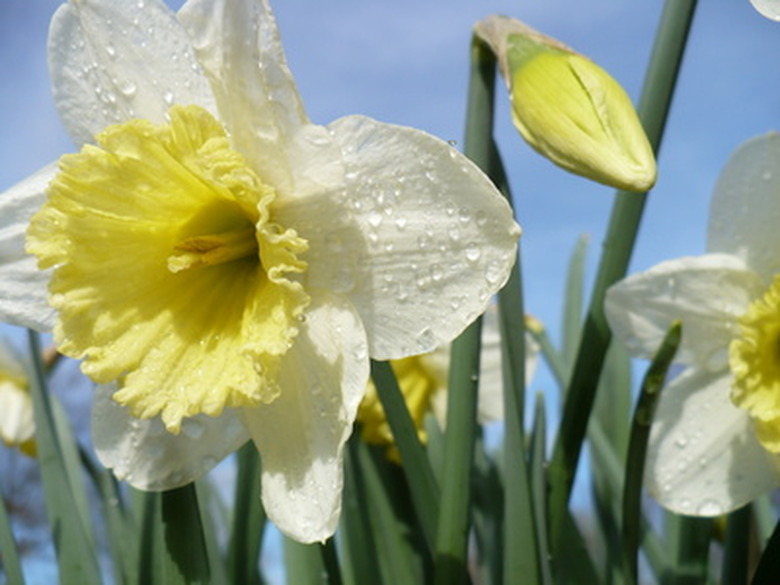How To Plant Flower Bulbs In New England
Things Needed
- Spade, hoe or tiller
- Organic matter
- Fertilizer
- Trowel
- Water
- Mulch
Connecticut, Maine, Massachusetts, New Hampshire, Rhode Island and Vermont make up the area known as New England. Even though New England is well-known for its cold and often harsh winters, beautiful gardens adorn the area from spring until fall. Bulbs are often a New England gardener's favorite. There are many bulbs that can survive the winter months and will faithfully return year to year with little work. Other, warmer-climate bulbs can still be planted in the spring and enjoyed during the summer and fall months.
Step 1
Determine which U.S. Department of Agriculture plant hardiness zone you live in (see Resources). New England consists of zones 3 through 7, and knowing which zone you live in will help determine which bulbs you can plant in your zone and when.
- Connecticut, Maine, Massachusetts, New Hampshire, Rhode Island and Vermont make up the area known as New England.
- New England consists of zones 3 through 7, and knowing which zone you live in will help determine which bulbs you can plant in your zone and when.
Step 2
Choose a location to plant your bulbs. Most bulbs need full sun (at least six hours of sunlight per day) and soil that drains water well. Since New England soil can contain a lot of clay—which slows water drainage—notice if puddles remain after five hours of a hard rain. If they do, your soil does not drain well and you will need to amend the soil (e.g., with sand and compost) or choose another location.
Step 3
Decide if your bulbs are winter hardy in your zone. Tulips, daffodils and crocuses are examples of bulbs that are most likely hardy in your New England climate. Bulbs that are not winter hardy in your climate are planted in the spring after the last frost of the season, which in New England typically occurs as early as the end of March in zone 7 or as late as the end of May in zone 3.
- Choose a location to plant your bulbs.
- If they do, your soil does not drain well and you will need to amend the soil (e.g., with sand and compost) or choose another location.
Step 4
Loosen the soil to a depth of 8 to 12 inches. It's best to do this (and the next two steps) in the summer for a fall planting or in the fall for a spring planting. Use a spade, tiller or hoe for this step. Also, remove large rocks, which are common in many parts of New England, such as in Maine.
Step 5
Incorporate organic matter into the top 8 inches of soil. Examples include compost, peat moss or well-rotted manure. Apply at a rate of about 3 bushels per 100 square feet of garden space. Organic matter adds valuable nutrients to the soil and improves drainage in soil that does not drain well (as aforementioned). It also helps slow down water drainage in sandy soils, as is common along much of New England's coastal areas.
- Loosen the soil to a depth of 8 to 12 inches.
- Organic matter adds valuable nutrients to the soil and improves drainage in soil that does not drain well (as aforementioned).
Step 6
Mix in fertilizer into the top 6 inches of soil. Use a low-nitrogen fertilizer, such as one labeled 5-10-10. Apply 1 pound per 100 square feet.
Step 7
Wait until the fall to plant your hardy bulbs. In zones 3 to 5, plant from early September until early October. In zones 6 to 7, plant your bulbs from mid-October until early November. Bulbs not hardy in your zone will have to wait until the spring after the last frost. In the meantime, store them in a cool (around 60 to 65 degrees Fahrenheit), dark location, such as in your garage.
- Mix in fertilizer into the top 6 inches of soil.
- In zones 6 to 7, plant your bulbs from mid-October until early November.
Step 8
Plant the bulbs with the tips facing up and at a depth that is equal to two to three times the height of the bulbs. For instance, if your bulb is 1 inch tall, plant the tip 2 to 3 inches below the soil. Space multiple bulbs according to their kind, usually anywhere between 1 to 10 inches depending on the bulbs' size and mature growth.
Step 9
Backfill the soil and gently pack it down with the palm of your hands. Water the area with about an inch of water. For fall New England plantings, cover the planting site with about 2 to 4 inches of organic mulch, such as bark, pine needles, leaves, straw or wood chips.
